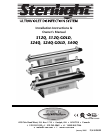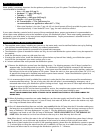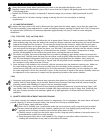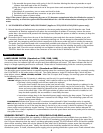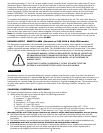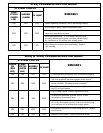
2
INSTALLING YOUR DISINFECTION SYSTEM:
• The complete water system, including any pressure or hot water tanks, must be sterilized before start up by flushing
with chlorine (household bleach) to destroy any residual contamination.
• The disinfection system should be connected to a ground fault interrupter.
• The disinfection system is intended for indoor use only, do not install disinfection system where it may be exposed to
the weather.
• Install the disinfection system on cold water line only.
• If treating the entire house, install the disinfection system before any branch lines. Ideally, your disinfection system
should be the last treatment your water receives prior to use.
• A 5 micron sediment filter must precede the disinfection system.
1. Remove the disinfection system from the shipping carton. For shipping purposes, the UV lamp is packed in a
separate tube. Set the lamp aside for use later. The disinfection system should be mounted in the horizontal
position, with the inlet/outlet ports facing up. If the system must be installed in the vertical position, make sure
the inlet port is the one at the bottom of the system. Mount the unit in a clear space with at least 36” (91.5 cm)
of space at the lamp end to facilitate lamp and or quartz sleeve removal. Fasten the disinfection system to a
suitable mounting platform with reinforcements.
2. It is recommended to install a suitable flow restrictor in order that the flow rate not exceed the manufacturers
recommended flow rating. The use of a by-pass with shut-off valves is recommended for emergency use of
untreated water when your disinfection system is being serviced. Apply two turns of Teflon tape around the port
threads to ensure a tight joint before connecting unions.
Note: When the UV unit has been by-passed for ser
vice, the complete water system must be sterilized once
again with chlorine to destroy any contamination that may have passed during by-pass.
DO NOT SOLDER CONNECTIONS WHILE ATTACHED TO THE DISINFECTION SYSTEM AS THIS COULD DAMAGE THE
O-RING SEALS.
3. When all plumbing connections are made, slowly turn on the water supply and check for leaks. The most likely
cause for leaks is from the o-ring seal. In case of a leak, shut water off, drain cell, remove the retainer nut, wipe
the o-ring and threads clean and re-install.
4. Once it is determined that there are no leaks, very carefully slide the UV lamp into the UV chamber making sure
the lamp pins are accessible for connection with the lamp connector cable. Attach the lamp connector to the UV
lamp, as outlined in “UV Lamp Replacement” on page 3
. Plug the disinfection system into the ground fault
interrupter, and check to see if the UV lamp is illuminated. NEVER LOOK DIRECTLY AT THE BURNING UV
LAMP. Allow the water to r
un for a few minutes to clear any air or dust that may be in the cell.
Note: When there is no flow, the water in the cell will become warm, as the UV disinfection system lamp is always
on. To remedy this, run a cold water tap anywhere in the house for a minute to flush out the warm water.
Note: As the system requires time to reach its full operating capacity, please allow the disinfection system to operate
3 - 5 minutes prior to using the water from the unit. In addition, to clear any air or debris from the system, open
the faucet and allow water to run through the disinfection system for 2 - 3 minutes.
WATER CHEMISTRY:
Water quality is extremely important for the optimum performance of your UV system. The following levels are
recommended for installation:
• Iron: < 0.3 ppm (0.3 mg/L)
• Hardness*: < 7 gpg (120 mg/L)
•
Turbidity: < 1 NTU
• Manganese: < 0.05 ppm (0.05 mg/L)
•
Tannins: < 0.1 ppm (0.1 mg/L)
• UV Transmittance: > 75% (call factory for
recommendations on applications where UVT < 75%)
* Where total hardness is less than 7 gpg, the UV unit should operate efficiently provided the quartz sleeve is
cleaned periodically. If total hardness is over 7 gpg, the water should be softened.
If your water chemistry contains levels in excess of those mentioned above, proper pre-treatment is recommended to
correct these water problems prior to the installation of your UV disinfection system. These water quality parameters can
be tested by your local dealer, or by most private analytical laboratories. Proper pre-treatment is essential for the UV
disinfection system to operate as intended.



